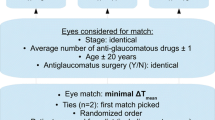Abstract
Purpose: Pseudoexfoliation syndrome is oneof the most frequent causes of open-angleglaucoma and is statistically significantassociated with a high risk of hypertension, angina,myocardial infarction or stroke and retinal veinthrombosis. The aim of this study was toevaluate the pulsatile ocular blood flow (POBF)in pseudoexfoliation syndrome without(PEX) and with glaucoma (PEG).Methods: Seventeen eyes with PEX, 17 withPEG and 11 normal eyes of age-matchedpatients were enrolled. A complete ophthalmologicalexamination included measuring thePOBF with the Langham Pneumotonometer as well asthe nerve fiber layer thickness byscanning laser polarimetry (GDxTM). Results: The blood flow parameters, pulsevolume and POBF, were statisticallysignificant different between normals and patientswith PEG (p < 0.003, t-test). A negativecorrelation between the intraocular pressure andthe POBF was found for all eyes tested.Analysis of GDx? parameters showed a negativecorrelation for the ``number'' with thePOBF and a positive one for ellipse modulation.Conclusion: Although pseudoexfoliation is reportedto be a systemic diseasemeasurement of the POBF could not detect any differencebetween normals and PEX, but wasstatistically significant different in PEG.Assessments of nerve fiber layer thickness asdetermined by scanning laser polarimetry alsoshowed a correlation with POBF in someparameters tested.
Similar content being viewed by others
References
Lindberg JG. Clinical investigations on depigmentation of the pupillary border and translucency of the iris. In cases of senile cataract and in normal eyes in elderly persons. Academic Dissertation, Helsinki, 1917. English translation by Tarkkanen A, Forsius H. Acta Ophthal Suppl 1989; 190, vol. 66, University Press, Helsinki.
Vogt A. Ein neues Spaltlampenbild des Pupillengebietes: hellblauer Pupillensaumfilz mit Häutchenbildung auf der Linsenvorderkapsel. Klin Monatsbl Augenheilkd 1925; 75: 1-12.
Dvorak-Theobald G. Pseudoexfoliation of the lens capsule: Relation to “true” exfoliation of the lens capsule as reported in the literature and role in its production of glaucoma capsulocuticulare. Am J Ophthalmol 1954; 37: 1-12.
Schlötzer-Schrehardt U, Koca MR, Naumann GOH, Volkholz H. Pseudoexfoliation Syndrome. Ocular manifestation of a systemic disease. Arch Ophthalmol 1992; 110: 1752-1756.
Brooks AMV, Gillies WE. The presentation and prognosis of glaucoma in pseudoexfoliation of the lens capsule. Ophthalmology 1988; 95: 271-276.
Naumann GOH, Schlötzer-Schrehardt U, Küchle M. Pseudoexfoliation syndrome for the comprehensive ophthalmologist. Ophthalmology 1998; 105: 951-968.
Wollensack J, Becker HU, Seiler T. Pseudoexfoliation syndrome and glaucoma. Does glaucoma capsulare exist? German J Ophthalmol 1992; 1: 32-34.
Freyler H, Radax U. Pseudoexfoliationssyndrom - ein Risikofaktor der modernen Kataraktchirurgie? Klin Monatsbl Augenheilkd 1994; 205: 275-279.
Mitchell P, Wang JJ, Smith W. Association of pseudoexfoliation syndrome with increased vascular risk. AmJ Ophthalmol 1997; 124: 685–687.
Repo LP, Suhonen MT, Teräsvirta ME, Koivisto KJ. Color Doppler imaging of the ophthalmic artery blood flow spectra of patients who have had a transient ischemic attack. Correlations with generalized iris transluminance and pseudoexfoliation syndrome. Ophthalmology 1995; 102: 1199–1205.
Weinreb RN, Shakiba S, Zangwill L. Scanning laser polarimetry to measure the nerve fiber layer of normal and glaucomatous eyes. Am J Ophthalmol 1995; 119: 627–636.
Weinreb RN, Zangwill L., Berry CC, Bathija, Sample PA. Detection of glaucoma with scanning laser polarimetry. Arch Ophthalmol 1998; 116: 1583–1589.
Hoh ST, Greenfield DS, Liebmann JM, Hillenkamp J, Ishikawa H, Mistlberger A, Lim ASM, Ritch R. Effect of pupillary dilation on retinal nerve fiber layer thickness as measured by scanning laser polarimetry in eyes with and without cataract. J Glaucoma 1999; 8: 159–163.
Anton A, Zangwill L, Emdadi A, Weinreb RN. Nerve fiber layer measurements with scanning laser polarimetry in ocular hypertension. Arch Ophthalmol 1997; 115: 331–334.
Choplin NT, Lundy DC, Dreher AW. Differentiating patients with glaucoma from glaucoma suspects and normal subjects by nerve fiber layer assessment with scanning laser polarimetry. Ophthalmology 1998; 105: 2068–2076.
Krakau CET. Calculation of the pulsatile ocular blood flow. Invest Ophthalmol Vis Sci 1992; 33: 2754–2756.
Krakau CET. A model for pulsatile and steady ocular blood flow. Graefe's Arch Clin Exp Ophthalmol 1995; 233: 112–118.
Langham M, To'mey K. A clinical procedure for measuring the ocular pulse. Exp Eye Res 1978; 27: 17.
StatSoft, Inc. STATISTICA for Windows [Computer program manual]. Tulsa, OK: 1999; StatSoft, Inc.
Miller, J. Simultaneous Statistical Inference, 2nd ed., 1981 New York: Springer Verlag.
McKinnon SJ. Glaucoma, apoptosis, and neuroprotection. Current Opinion in Ophthalmol 1997, 8; II: 28–37.
James CB. Effect of trabeculectomy on pulsatile ocular blood flow. Br J Ophthalmol 1994; 78: 818–822.
Willianson TH, Harris A. Ocular blood flow measurement. Br J Ophthalmol 1994; 78: 939–945.
Silver DM; Farrell RA, Langham ME, O'Brien V, Schilder P. Estimation of pulsatile ocular blood flow from intraocular pressure. Acta Ophthalmol Suppl 1989; 191: 25–28.
Boles Carenini A, Sibour G, Boles Carenini B. Differences in long-term effect of timolol and betaxolol on pulsatile ocular blood flow. Surv Ophthalmol 1994; 38: 118–124.
Quaranta L, Manni G, Donato F, Bucci MG. The effect of increased intraocular pressure on pulsatile ocular blood flow in low tension glaucoma. Surv Ophthalmol 1994; 38: 177–182.
James CB, Smith SE. Pulsatile ocular blood flow in patients with low tension glaucoma. Br J Ophthalmol 1991; 75: 466–470.
Cursiefen C, Händel A, Schönherr U, Naumann GOH. Das Pseudoexfoliationssyndrom bei Patienten mit retinaler Venenast-und Zentralvenenthrombose. Klin Monatsbl Augenheilkd 1997; 211: 17–21.
Helbig H, Schlötzer-Schrehardt U, Noske W, Kellner U, Foerster M, Naumann GOH. Anterior-chamber hypoxia and iris vasculopathy in pseudoexfoliation syndrome. Ger J Ophthalmol 1994; 3: 148–153.
Choplin NT, Lundy DC, Dreher AW. Differentiating patients with glaucoma from glaucoma suspects and normal subjects by nerve fiber layer assessment with scanning laser polarimetry. Ophthalmology 1998; 105: 2068–2076.
Author information
Authors and Affiliations
Rights and permissions
About this article
Cite this article
Mistlberger, A., Gruchmann, M., Hitzl, W. et al. Pulsatile ocular blood flow in patients with pseudoexfoliation. Int Ophthalmol 23, 337–342 (2001). https://doi.org/10.1023/A:1014454714574
Issue Date:
DOI: https://doi.org/10.1023/A:1014454714574



